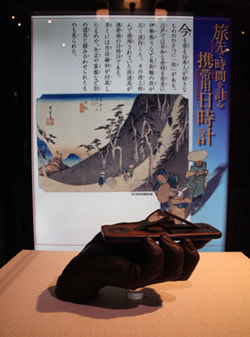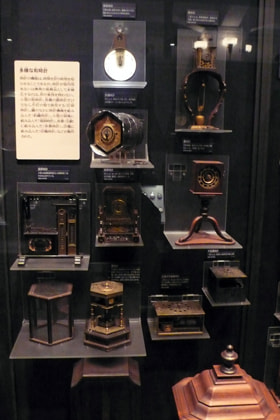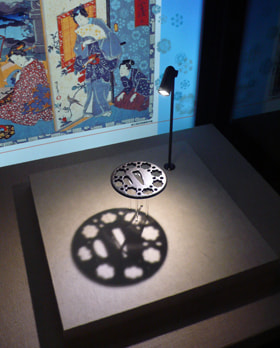
Portable sundial
Ikemoto : Here is the section of "To know the time." While clocks tell the time, Japanese people had defined time in a unique way since early times. In Japan, there was the "temporal hour system," which may represent the fact that Japanese had lived in harmony with nature. In the system, a day the time between sunrise and sunset or a night between sunset and sunrise, is divided into six equal parts, each of which is counted as the basic time unit. Naturally, the length of the basic time unit varies according to seasons, day or night. The system may represent Japanese people's traditional, nature-based way of life in which they defined time according to movements of nature.

This is the exhibition of Japanese clocks. Specially structured clocks are needed for the temporal hour system because the length of the basic time unit varies according to day, night or seasons. Japanese clocks have a mechanism that can properly display the irregular time. So, Japanese have had very sophisticated technologies since early times, and applied them to their lives. These Japanese clocks prove Japan's technological level at that time. In the Meiji Period, the irregular time-measuring system was abolished, and the regular time-measuring system was adopted, so Japanese clocks cease to be used. However, production of new mechanical clocks started. Since then, the clock industry in Japan has developed significantly, and become the world's leading industry.(continued in the lower left column)
his is the section of "To know the microscopic world." The exhibition is about technologies relating to microscopes. What have Japanese observed through microscopes since early times? At first, microscopes were imported from abroad. It was the Western technology. Here, Japanese people's interest especially in nature and their objects of concern are explained through the exhibits. Japanese had interests in a variety of things and observed them. For example, when they observed very small things such as mosquito by using a microscope, they were amazed, saying that it looked like a monster. This is a picture of snow crystals. They observed snow crystals through microscopes, drew patterns of various snow crystals on pieces of paper, and preserved them. Objects of their interests and curiosities, and observation techniques have been applied to natural history and other fields as time has passed. Moreover, microscopes have been domestically produced, and, in the present, Japan's manufacturing techniques of microscopes are very sophisticated.(continued in the next page)

In this section, a sword guard designed with a snow crystal pattern is exhibited as an example of applying objects of their interests into their lives. In this way, objects were seen through microscopes and their patterns were then applied to various ornamentations. There was an interesting effect that those ornamentations set the trend.

Portable sundial












